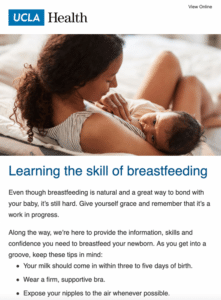Summary
- Research patient needs and preferences to gain insights for better targeting. Then, segment your audience to deliver relevant, tailored content.
- Create content that addresses what’s most important to your audience right now – building relationships with your readers over time.
- Regularly analyze campaign performance to identify improvements and adjust strategies accordingly.
Creating a lasting connection with patients after discharge
Imagine this: You gave birth to your first child days ago. Before that, you’d never held a baby in your life. Your nurse is reviewing your discharge instructions, and your head is spinning. You are still physically recovering from childbirth — and about to head home with a newborn. Overwhelmed doesn’t even begin to cover it.
That frazzled feeling isn’t unique to new parents. Other people who are discharged from the hospital feel it, too. For example, patients who had major surgery or those who just got a life-altering diagnosis. They may feel overwhelmed, abandoned, and unsure where to turn if they need help.
As a healthcare marketer, you can step in with tailored, helpful content. The right resources can lower patients’ anxiety and ensure they know they can turn to your organization for questions or support.
This level of care and guidance keeps patients engaged, increasing patient loyalty. And it makes sure you stay top of mind for when they need care.
So how can you stay in touch with your patients once they’ve left?
Our client UCLA Health asked this same question before they turned to healthcare email marketing for the solution. Through comprehensive market analysis, they discovered that patients (particularly new parents) are hungry for personalized, timely communication after leaving the hospital. Patients have questions, and who better to provide the answers than the hospital they just left?
To leverage that insight and grow patient loyalty, UCLA Health zeroed in on those who recently had their first baby at one of UCLA Health’s hospitals. After analyzing demographic data, the marketing team learned that new parents valued clear, practical advice on postpartum care, newborn care, and breastfeeding. The team also learned that video content and visual aids significantly improved engagement and comprehension.
A prime example: UCLA Health’s new parent email campaign
With these audience insights, a new project was born: the new parent email campaign. To bring the campaign to life, UCLA Health followed these steps:

Data segmentation and personalization
Having audience data is one thing — knowing how to use it is another. Through its marketing automation platform, Eloqua, UCLA Health examined its existing patient data and segmented new parents based on:
- Delivery method: Vaginal birth or cesarean section
- Feeding plans: Breastfeeding or formula feeding
- Geographic location: To tailor content to regional needs and resources
- Preferred language: To provide content in English or Spanish, based on the patient’s preferred language
By creating these segments, UCLA Health could deliver highly personalized content that resonated with specific groups of new parents. For example, they can send emails about breastfeeding support to parents who indicate breastfeeding as their plan. Those who indicate they plan to formula feed get relevant information about that.
Content inventory
Working together, UCLA Health and Aha Media Group took stock of all parenting- and pediatrics-related content published by UCLA Health in its Newsroom, print magazines, YouTube channel, and medical service pages. This turned into a content inventory that the team could reference and link to throughout the new parent email campaign.
After all, why reinvent the wheel if you already have what makes it turn?
Email campaign structure
From there, UCLA Health and Aha Media used the content to build an 8-week-long email campaign consisting of 6 key messages:
- Congratulations email: Sent within 3 days of discharge, this email offers a congratulatory message, shares essential contact information, and provides links to relevant resources that are top of mind for new parents.
- What to expect after giving birth: This email is segmented by delivery method (vaginal or cesarean) and offers tailored advice on recovery, pain management, and self-care.
- Infant feeding and breast care: This email includes two versions, one for breastfeeding and one for formula feeding. Each email provides essential information, support resources, and expert guidance.
- Postpartum care: This email covers general postpartum health, newborn care, and mental health support. It includes links to relevant articles and videos from UCLA Health’s website.
- Life with your newborn: This email focuses on practical tips for managing life with a newborn, such as sleep routines, feeding schedules, and child development milestones. It also includes information on pediatric care and family support services.
- Getting back to primary care: This final email encourages new parents to schedule routine appointments for themselves and provides information on pelvic floor health and support groups.
All emails are available in English and Spanish and sent based on language preference.
This content creation didn’t happen in a silo — it involved close collaboration with UCLA Health’s OB-GYN and pediatrics teams. This collaboration ensured the information was accurate, up-to-date, and aligned with the latest medical guidelines.
Measuring success and optimization
UCLA Health’s campaign launched in April 2024, and it’s still running as of this writing. So far, the team is excited about the results and potential impact on patient loyalty.
With more than 1,900 emails sent, the results across all emails include:
- 53%: Average unique open rate
- 24%: Average total click-through rate
- 14%: Average unique click-through rate
- 20%: Average click-to-open rate
- 0%: Unsubscribe rate
Key takeaways for healthcare marketers
While UCLA Health’s email campaign targets new parents, the underlying principles hold true for any patient demographic. If you want to use email marketing to grow patient loyalty, focus on these key guidelines:
- Understand your audience: Develop a deep understanding of your target audience’s needs, challenges, and preferences. Conduct audience research, gather demographic data, and uncover insights.
- Create personalized experiences: Use that data to segment your audience into specific groups so you can deliver more personalized, relevant content.
- Focus on value: When your audience is segmented and specific, the content you create will be more helpful and relevant. Write about what’s top of mind for your audience when they’re set to receive the email.
- Build relationships: Through a targeted, personalized, triggered email campaign, you can grow relationships with your patients over the long term. Your organization stays top of mind, and patients will continue to trust you with their health.
- Measure and optimize: Continuously analyze your campaign performance to find opportunities for improvement. Do you have new data that allows you to further segment your audience? Is there a fresh, relevant content piece you could add to your campaign? Adjust as necessary.
Do patients know they can turn to your digital channels for clear, trustworthy, and relevant information after leaving your hospital? If the answer is no, it’s time to change that. We can help you stand out in the inbox, connect with your readers, and provide value that keeps them coming back.
Emailed-out? We can help
Make email one of your most valuable channels. Learn more about our hospital newsletter writing and email marketing services today.



